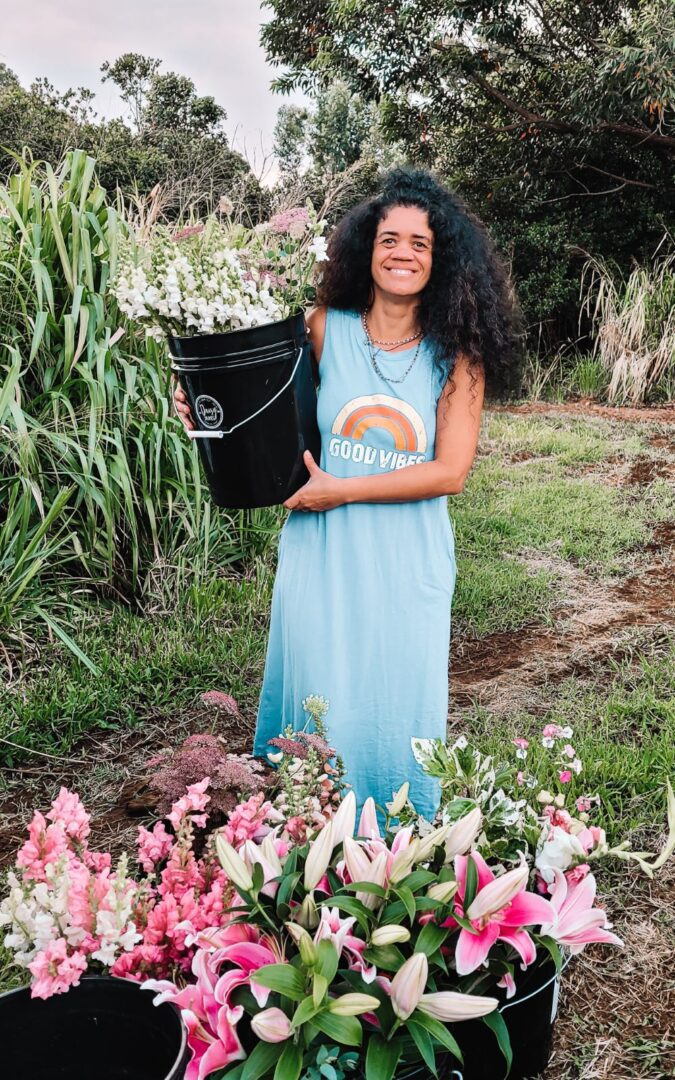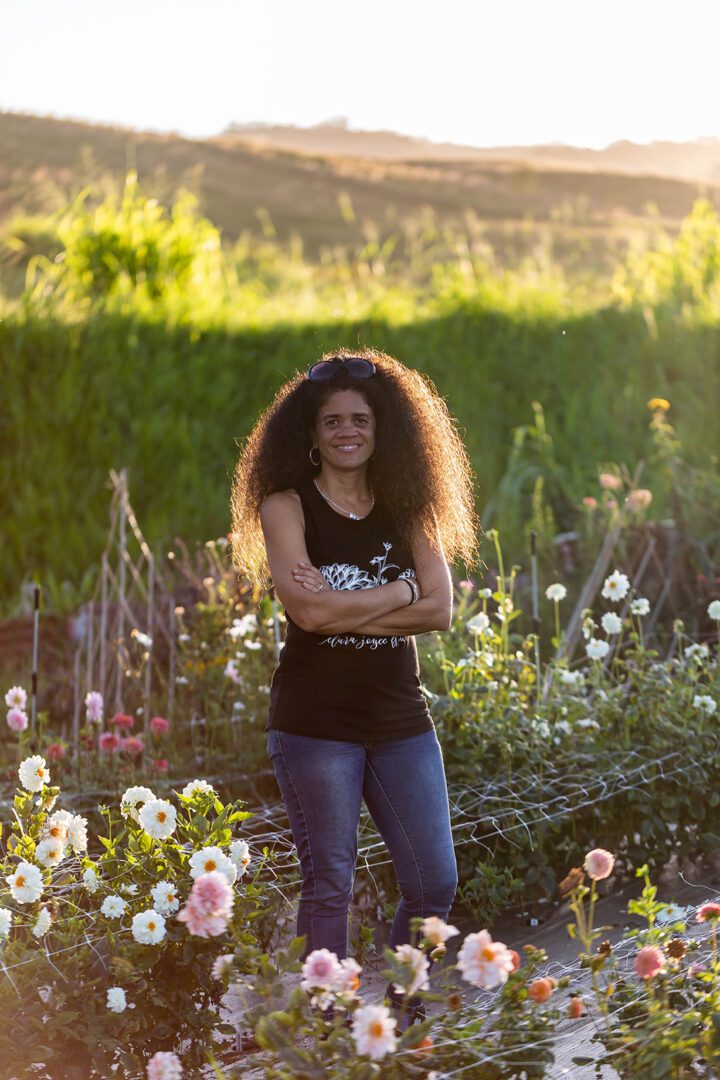Meet the Woman Who Coaxes Dahlias to Grow in Hawaii
By Linda Lee

Think of Hawaiian flowers. Probably orchids, frangipani, jasmine, bird of paradise, anthurium, and maybe heliconia or lobster claws. Then wonder at Christian Ingalls, who grows dahlias, snapdragons, cosmos and zinnias, better suited to the continental United States. Plus, there is the name of her flower farm, not Aloha Growers, or Polynesian Paradise, but Daisy Dukes.
What?
“I often wear short jean shorts or even bikinis when I am farming, because it is so hot here,” she says. “I am also a very high-energy, positive person, so I wanted our farm name to be fun!”
And fun it is. the Daisy Dukes Flower Farm has a $25 U-pick event on Thursday evenings and Saturday mornings, with stiff rules. You must use their container (a 32-ounce stadium cup) and their clippers (so you don’t bring any fungus or pests into the farm). You have two hours. There is a limit of five dahlias a cup. But there are also those other flowers, including lilies, as well as filler flowers. One rule: snapdragons should be cut close to the ground, not snipped off up near the top, so the next snapdragon will come up tall.
Customers are urged to strip leaves off the bottom of stems. There is also a $50 option that nets a two-gallon bucket of flowers. For those who want to learn what to do with such bounty, Daisy Dukes Flower Farm offers workshops. And the farm is available for events, including weddings.

On certain Saturday nights there is a $50 Bloom Bar, on a location on the water. Since it is private property, with no liquor license, the $50 pays for a mason jar to be filled with flowers. Basically, it’s a party. A vintage pink cooler is filled with ingredients. Music plays. “The best part,” Christian says, “is that I show everyone how to make a botanical cocktail/mocktail using Simple Goodness Sisters Simple Syrups and share the recipe along with all of the ingredients, including our edible flowers.”
Always the instructor. Did we mention that Christian Ingalls, 46, is also a full time first grade teacher?
From her rather remote flower farm on the north shore of the big island, it’s a 12-minute drive to a main road in the unincorporated community of Papa’Aloa. Then it’s another 40 minutes to the school where she teaches in Waimea.
Her superpower? Multitasking. After school, she handles the farm, which includes not just flowers but pigs, ducks, goats and other critters. She buys all of the seed and tubers, heritage and rare if possible, and saves seed from previous crops. She sells wholesale and retail, providing flowers not just for Hawaii but inter-island. She hires staff, handles communications, harvesting, ordering, and payroll. The farm also schedules floral design services, and those workshops.
Why Grow Dahlias?
Why not just grow orchids, like everyone else
“First of all, I love dahlias and I think they go with everything. We wholesale them at $2 a stem, which makes them a great value since they are local and shipping them wholesale from the mainland is over $5 stem.
“I love the tropical flowers, but missed mainland ‘temperate’ flowers,” she adds. When she started her flower farm in 2019, “I decided to learn how to grow my own and, like so many, I took the Floret course, the Gardeners Workshop course as well as others.”
When she says “Floret” she means she went to the Floret Flower Farm, a mecca for flower growers in Washington State’s Skagit Valley, It offers heirloom seeds, gardening gear, books, videos, a cut flower operation and courses for flower farmers.
“I would say that all of the classes that I have taken really helped me get going,” Christian says. That includes her studies at Humboldt State, in California, (now Cal State Polytechnic University). She got a BA in marine biology from the University of Hawaii Hilo after she moved to Hawaii in 1999 on a National Student Exchange. And she has a masters degree in education.
Still, growing dahlias and snapdragons had an adventurous start.
“There aren’t a lot of places in the world that have the humidity level that we have, with our volcanic soil. I have had to go with my gut, do a lot of research and kind of trick the system of nature to grow these temperate flowers here.
“We just try everything and push the envelope.”

One advantage of the climate in Hawaii, of course, is that temperate flowers can be grown year around. When they go to seed, they are re-seeded. But even in Hawaii, there can be adverse weather.
“This past year we had a drought even though we are 25 minutes away from the rainiest town in the United States. I wanted to know how our dahlias would handle the drought. And, since I live off of the grid and we usually don’t get very much rain, I didn’t take the steps to hand water. Instead I observed daily what was happening, so that I could use that information in the future.”
The dahlias survived. And today the weather has improved.
It is those small triumphs that please Christian Ingalls, like any good farmer.
“We dabble in a lot, but we are proud of who we are and how far we have come. I would say that I am also proud of not doing what everyone else does.
“On this little ‘Big Island’ we are known.”

Linda Lee is a former writer and editor at The New York Times.
